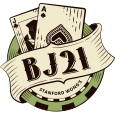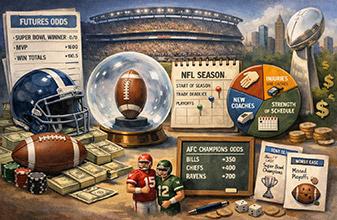Flat or Varying Sports Bets?

Sharp Sports Betting is a tool for those interested in winning money at sports betting. The book explains the most common sports bets, what all the numbers mean, and the mathematics behind the numbers.
The material presented in this article generally is called the Kelly Criterion, and credit for being the first person to publish it goes to John L. Kelly.
The Argument for Flat Bets
Whether you are betting in Las Vegas or elsewhere, or even online, figuring out how much you have won or lost is easier if all your bets are identical, but that’s the only justification for betting the same amount on every pick. There is no theoretical reason to restrict yourself to making the identical bet on every pick.
Of course if you have the same confidence in all the picks you make, and none of them stands out as extra special, then you might as well bet the same amount on every pick.
The Argument for Varying Bets
There are two reasons for varying your bet size. One reason is the terms of the bet; if the terms are other than -110, then your optimal bet size will be other than 1.1 times your MinWin.
The other reason you should vary your bet size is some bets are stronger than your MinEdge. You should want to bet more when you have a bigger edge. Wanting to get even is not a valid reason for making a bigger bet. Your bet size should depend on the terms and your edge, and not how far behind or ahead you are for the weekend.
How the Terms Affect Bet Size
It’s not your bet size that should be held constant; it’s the dollar amount of your win. For all bets you find that you think give you your MinEdge, your optimal bet size is whatever you must bet in order to achieve your MinWin.
If your MinWin is $100 and the terms are the standard -110, then bet $110 to try to win $100..If your MinWin is $100 and the terms are -160, then bet $160 to try to win $100.
If your MinWin is $100 and the terms are +125, then bet $80 to try to win $100.
If your MinWin is $100 and the odds are 20:1, then bet $5 to try to win $100.
How Your Edge Affects Bet Size
If you are like me, you are constantly scrutinizing sides and totals and props, and whenever you think you have more than your MinEdge, you make a bet. Occasionally a game will come along on which you believe you have a much larger edge. The mathematics justify betting more on that pick than on picks where you have your MinEdge.
Of course you have to be right. Not right in terms of winning that particular bet, but right in terms of assessing your actual edge. The best way to be sure you really do win a high percentage of picks on which you think you have a larger edge is to keep separate track of those Picks.
One caution when keeping records: Be sure you identify each larger-edge pick before the game starts. It’s not fair to wait until a game has started (or is over) to decide how big an edge you thought you had on a pick. If you think you have a larger edge on a pick, write down that prediction before the game starts. Then when you review your records to see how well your largeredge picks did, look at the results for only the picks that you wrote down as having a larger edge before the game started. You must be honest with yourself here if you really want to verify that your larger-edge picks really do win extra often. A pick that you treated as MinEdge before the game started but afterward realized had a larger edge must be counted as a MinEdge pick.
Once you have proven to yourself that your largeredge picks perform well, then you can justify betting more on them. How much more? For one thing, keep in mind that you must be able to live with the bet. If you lose sleep worrying about a bet on a game yet to be played, you have bet too much no matter what the mathematics say. If losing a bet would change your lifestyle or be a cause for anxiety or depression or worry, then you should not bet that much, no matter what the mathematics say.
Suppose that you believe you have discovered a larger-edge pick. Further suppose that any amount you might bet would be small compared to your total wealth, and that losing the bet would not bother you at all. How much should you bet?
Mathematics can come up with an answer only if you can somehow put a value on how good this pick is compared to your MinEdge.
The mathematical answer is to divide the bet size by the ratio of your edge on the larger-edge-pick to your MinEdge.
Suppose your MinEdge is five percent, and you have a pick that you think gives you a ten percent edge. Ten divided by five is two, so the optimal bet size is to bet twice as much on this pick. If your MinWin is $100 and the terms are -110, then on a double-MinEdge pick, bet $220 to win $200.
If you want to learn more about optimal bet size and how it applies to gambling games, read the literature of blackjack. When blackjack players use the expression “optimal bet size,” they mean sizing their bets according to the edge they have on a particular hand with respect to the size of their bankroll. Another field in which optimal bet size has been extensively researched and written about is the world of finance.
Bankroll Size
What is the size of your bankroll for the purpose of betting sports? The definition I prefer is: Your bankroll is the amount that, if lost, would put you out of the business of making bets. You might be a millionaire, but if losing $10,000 would cause you to stop betting sports, then your bankroll for the purpose of sizing sports bets Is only $10,000.
Simultaneous Bets
One problem faced by sports bettors is how to adjust for the risk inherent in making simultaneous bets. You should not put yourself in a situation where losing all of your bets some weekend will result in your bankroll being wiped out.
I could calculate what your bet sizes should be if you gave me enough information. I’d need to know the size of your bankroll, and I’d need information about every bet you wanted to make simultaneously. The information I would need on each bet is: 1) your edge, and 2) the terms, if any differ from the standard -110.
Normally when you are betting sports you don’t draw up a complete list of intended bets before making a single bet. In fact it would not be practical to do that even if you wanted to, because some of the good bets you discover will not be there waiting for you if you intend to come back later for them. When you find a juicy situation, typically you must jump on it quickly before someone else notices it and bets it, causing the line to move against you.
Bankroll and MinEdge Determine MinWin
What is needed is a rule of thumb that you can use to choose a MinWin that makes sense in relation to your MinEdge and your bankroll.
For a MinEdge of five percent, I suggest a MinWin no larger than 1.5 percent to 2.5 percent of your bankroll. A smaller MinWin than that is okay, but a larger MinWin could be devastating if you have a horrible weekend. If you choose a MinWin of 1.5 to 2.5 percent of your bankroll, you can make a lot of simultaneous bets before running out of cash. You seldom will be in the embarrassing position of finding a high-edge prop but being unable to exploit it due to having an empty wallet.
With a MinWin of 1.5 to 2.5 percent of your bankroll, a bad weekend can put a serious dent in your bankroll, but it won’t wipe you out.
If you have a MinEdge of five percent and follow my advice on MinWin, your MinWin will be around $200 for every $10,000 in your bankroll.
This is part of an occasional series of articles.
Excerpted with permission from Sharp Sports Betting by Stanford Wong, edited for this format.











Please log in or register to leave a comment